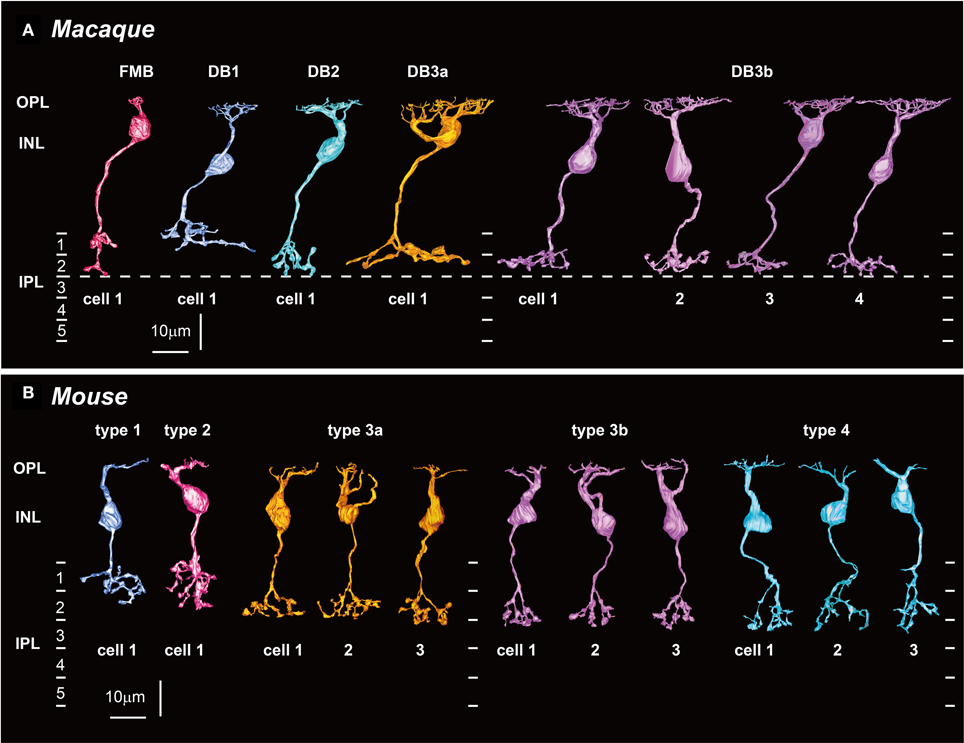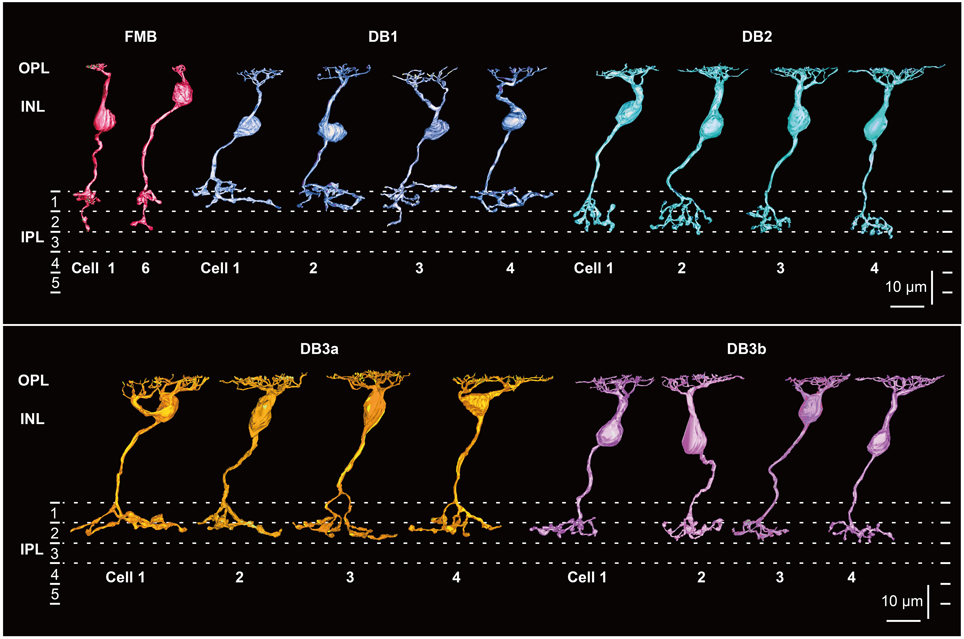Corrigendum: (1) Some OFF Bipolar Cell Types Make Contact With Both Rods and Cones in Macaque and Mouse Retinas; (2) OFF Bipolar Cells in Macaque Retina: Type-specific Connectivity in the Outer and Inner Synaptic Layers
- 1Studio Retina, Nishinomiya, Japan
- 2Department of Biology, Hyogo College of Medicine, Nishinomiya, Japan
A corrigendum on
Some OFF bipolar cell types make contact with both rods and cones in macaque and mouse retinas
by Tsukamoto, Y., and Omi, N. (2014). Front. Neuroanat. 8:105. doi: 10.3389/fnana.2014.00105
by Tsukamoto, Y., and Omi, N. (2015). Front. Neuroanat. 9:122. doi: 10.3389/fnana.2015.00122
In the upper panel of Figure 2 of article (1), and in the lower panel of Figure 1 of article (2), the side-view picture in the position of type DB3b cell 3 (DB3b-3) is wrong. This picture was mistakenly replaced with type DB2 cell 3 (DB2-3). Revised figures appear below. Also in the legend of Figure 2, INL should be “inner nuclear layer,” instead of “inner plexiform layer.” The top-view pictures of the axon terminal and dendrites of cell DB3b-3 in other figures and their morphological measurements in the text are all correct. Results and conclusions are unaffected.
Article (1)

Figure 2. Five types of OFF bipolar cells in macaque (A) and mouse (B) retinas. (A) FMB, DB1, DB2, and DB3a cells (one example of each; left) and DB3b cells (four examples, DB3b-1 to DB3b-4) that make contact with both rods and cones in the macaque retina (right). (B) T1 and T2 cells (one example of each type; left), and T3a, T3b, and T4 cells (three examples of each) that make contact with both rods and cones in the mouse retina (right). Potential homologous pairs between macaque and mouse are depicted using the same colors (such as FMB and T2 in red and DB2 and T4 in light blue). OPL, outer plexiform layer; INL, inner nuclear layer; IPL, inner plexiform layer. Dotted lines indicate 0, 20, 40, and 60% depths in IPL.
Article (2)

Figure 1. Morphology and stratification of FMB, DB1, DB2, DB3a, and DB3b types of OFF bipolar cells. FMB cell-1 and cell-6 (FMB-1 and FMB-6) are connected to M/L and S cones, respectively. Four cells (1–4) are displayed for each DB type. Each stratum of the IPL (1–5) is 6 μm thick. Strata 1–2 comprise the OFF sublamina.
Author Contributions
The authors had full access to all the content in this commentary and take full responsibility for the accuracy of the data. YT wrote the manuscript. NO checked the manuscript.
Conflict of Interest Statement
The authors declare that the research was conducted in the absence of any commercial or financial relationships that could be construed as a potential conflict of interest.
Keywords: monkey retina, basal synapse, ribbon synapse, neural circuits, serial section electron microscopy
Citation: Tsukamoto Y and Omi N (2015) Corrigendum: (1) Some OFF Bipolar Cell Types Make Contact with Both Rods and Cones in Macaque and Mouse Retinas; (2) OFF Bipolar Cells in Macaque Retina: Type-specific Connectivity in the Outer and Inner Synaptic Layers. Front. Neuroanat. 9:144. doi: 10.3389/fnana.2015.00144
Received: 17 October 2015; Accepted: 30 October 2015;
Published: 13 November 2015.
Edited by:
Nicolás Cuenca, University of Alicante, SpainReviewed by:
Ulrike Grünert, The University of Sydney, AustraliaSteven H. DeVries, Northwestern University, USA
Copyright © 2015 Tsukamoto and Omi. This is an open-access article distributed under the terms of the Creative Commons Attribution License (CC BY). The use, distribution or reproduction in other forums is permitted, provided the original author(s) or licensor are credited and that the original publication in this journal is cited, in accordance with accepted academic practice. No use, distribution or reproduction is permitted which does not comply with these terms.
*Correspondence: Yoshihiko Tsukamoto, ytsuka@hyo-med.ac.jp
 Yoshihiko Tsukamoto
Yoshihiko Tsukamoto Naoko Omi1
Naoko Omi1